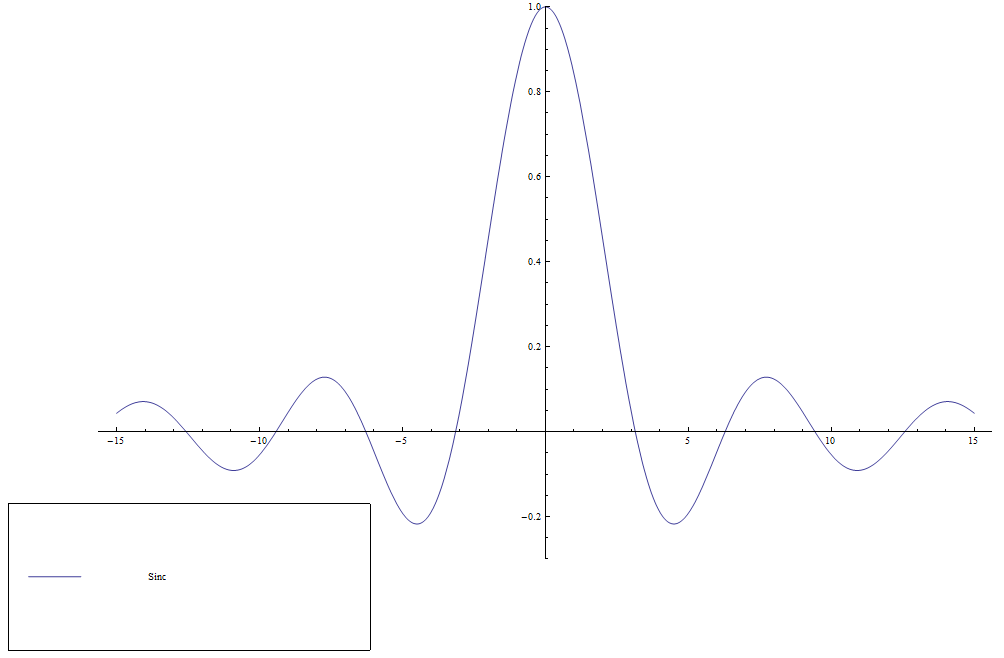Difference between revisions of "Sinc"
| Line 1: | Line 1: | ||
| − | The $\mathrm{sinc}$ function is defined by | + | The $\mathrm{sinc}$ function (sometimes called the unnormalized $\mathrm{sinc}$ function) is defined by |
$$\mathrm{sinc}(x) = \left\{ \begin{array}{ll} | $$\mathrm{sinc}(x) = \left\{ \begin{array}{ll} | ||
\dfrac{\sin x}{x} &; x \neq 0 \\ | \dfrac{\sin x}{x} &; x \neq 0 \\ | ||
| Line 16: | Line 16: | ||
<strong>Theorem:</strong> The following formula holds: | <strong>Theorem:</strong> The following formula holds: | ||
$$\mathrm{sinc}(x)=\displaystyle\prod_{k=1}^{\infty} \cos \left( \dfrac{x}{2^k} \right).$$ | $$\mathrm{sinc}(x)=\displaystyle\prod_{k=1}^{\infty} \cos \left( \dfrac{x}{2^k} \right).$$ | ||
| + | <div class="mw-collapsible-content"> | ||
| + | <strong>Proof:</strong> █ | ||
| + | </div> | ||
| + | </div> | ||
| + | |||
| + | {{:Sum of values of sinc}} | ||
| + | |||
| + | <div class="toccolours mw-collapsible mw-collapsed"> | ||
| + | <strong>Theorem:</strong> The following formula holds: | ||
| + | $$\displaystyle\sum_{k=1}^{\infty} (-1)^{k+1}\mathrm{sinc}(k)=\dfrac{1}{2}.$$ | ||
<div class="mw-collapsible-content"> | <div class="mw-collapsible-content"> | ||
<strong>Proof:</strong> █ | <strong>Proof:</strong> █ | ||
Revision as of 05:10, 18 May 2015
The $\mathrm{sinc}$ function (sometimes called the unnormalized $\mathrm{sinc}$ function) is defined by $$\mathrm{sinc}(x) = \left\{ \begin{array}{ll} \dfrac{\sin x}{x} &; x \neq 0 \\ 1 &; x=0. \end{array} \right.$$
- Complex sinc.png
Domain coloring of analytic continuation of $\mathrm{sinc}$ on $[-15,15] \times [-15,15] \subset \mathbb{C}$.
Properties
Theorem: The following formula holds: $$\mathrm{sinc}(x)=\displaystyle\prod_{k=1}^{\infty} \cos \left( \dfrac{x}{2^k} \right).$$
Proof: █
Theorem
The following formula holds: $$\displaystyle\sum_{k=1}^{\infty} \mathrm{sinc}(k) = \dfrac{\pi-1}{2},$$ where $\mathrm{sinc}$ denotes the $\mathrm{sinc}$ function and $\pi$ denotes pi.
Proof
References
Theorem: The following formula holds: $$\displaystyle\sum_{k=1}^{\infty} (-1)^{k+1}\mathrm{sinc}(k)=\dfrac{1}{2}.$$
Proof: █
